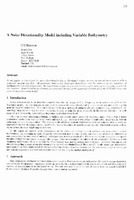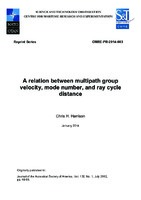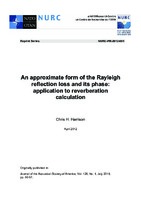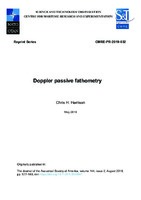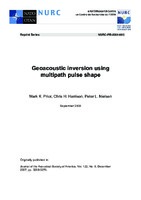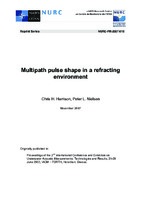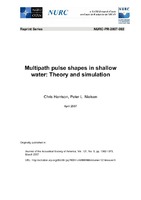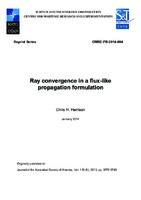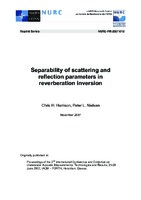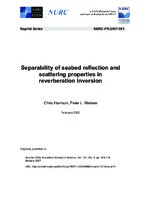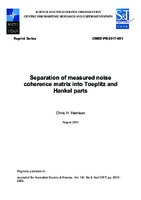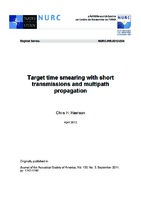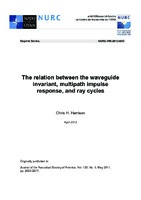Browsing Reprints by Author "Harrison, Chris H."
Now showing items 1-15 of 15
-
A noise directionality model including variable bathymetry
Harrison, Chris H. (NATO. SACLANTCEN, 1997)In this paper we investigate the noise directionality due to distributed surface sources m several envtronments with a uniformly sloping sea bed. Of particular interest are frequency dependence and the question of the ... -
A relation between multipath group velocity, mode number, and ray cycle distance
Harrison, Chris H. (CMRE, 2014/01)Weston's ray invariant or "characteristic time" in a range-dependent environment is exactly equivalent to the Wentzel-Kramers-Brillouin phase integral for ducted normal modes. By considering a ray element it is shown that ... -
An approximate form of the Rayleigh reflection loss and its phase: application to reverberation calculation
Harrison, Chris H. (NURC, 2012/04)A useful approximation to the Rayleigh reflection coefficient for two half-spaces composed of water over sediment is derived. This exhibits dependence on angle that may deviate considerably from linear in the interval ... -
Doppler passive fathometry
Harrison, Chris H. (CMRE, 2019/05)Passive fathometry is a technique whereby broadband ambient ocean noise received on an array of hydrophones is averaged and cross-correlated to produce a sub-bottom profile [Siderius, Harrison, and Porter (2006). J. Acoust. ... -
Geoacoustic inversion using multipath pulse shape
Prior, Mark K.; Harrison, Chris H.; Nielsen, Peter L. (NURC, 2008/09)Experimental data, measured in a shallow water region of the Mediterranean Sea, are used to show that the variation of received intensity with time is well described by existing expressions [Harrison and Nielsen, J. Acoust. ... -
Multipath pulse shape in a refracting environment
Harrison, Chris H.; Nielsen, Peter L. (NURC, 2007/11)Multiple boundary interactions in shallow water propagation introduce a more or less Gaussian angle distribution at a distant receiver. When all paths are added the result is 'mode-stripping', i.e. the steep rays are ... -
Multipath pulse shapes in shallow water: theory and simulation
Harrison, Chris H.; Nielsen, Peter L. (NURC, 2007/04)In shallow water propagation the steeper ray angles are weakened most by boundary losses. Regarding the sound intensity as a continuous function of angle it can be converted into a function of travel time to reveal the ... -
The ocean noise coherence matrix and its rank
Harrison, Chris H. (CMRE, 2019/05)An expression for the cross-spectral density matrix of ocean noise naturally separates into a Toeplitz part and a Hankel part [Harrison (2017). J. Acoust. Soc. Am. 141, 2812?2820]. The Toeplitz part is shown to be substantially ... -
Ray convergence in a flux-like propagation formulation
Harrison, Chris H. (CMRE, 2014/01)The energy flux formulation of waveguide propagation is closely related to the incoherent mode sum, and its simplicity has led to development of efficient computational algorithms for reverberation and target echo strength, ... -
Separability of scattering and reflection parameters in reverberation inversion
Harrison, Chris H.; Nielsen, Peter L. (NURC, 2007/11)A premise of reverberation inversion is that one can separate geoacoustic reflection properties from scattering properties since their effects on reverberation are distinguishable. Some doubt has been cast on this premise ... -
Separability of seabed reflection and scattering properties in reverberation inversion
Harrison, Chris H.; Nielsen, Peter L. (NURC, 2007/02)Separation of scattering properties (Lambert's mu) from reflection properties (the reflection loss angle derivative alpha) presents difficulties in the geoacoustic inversion of long range reverberation in isovelocity ... -
Separation of measured noise coherence matrix into Toeplitz and Hankel parts
Harrison, Chris H. (CMRE, 2017/08)The cross-spectral density of ocean ambient noise is usually estimated from the product of the complex hydrophone signals, each of which already corresponds to the summed responses of sources from all angles. The true ... -
Target detection and location with ambient noise
Harrison, Chris H. (NURC, 2008/09)By placing a vertical array in an ambient noise field and forming an upward and a downward beam one obtains two time series which can be cross correlated to reveal a subbottom profile of the seabed [Siderius et al., J. ... -
Target time smearing with short transmmissions and multipath propagation
Harrison, Chris H. (NURC, 2012/04)In active sonar the target echo level is often estimated with a propagation model that adds all multipath arrivals. If the (post-correlator) transmitted pulse is short compared to the multipath time spread then there is ... -
The relation between the waveguide invariant, multipath impulse response, and ray cycles
Harrison, Chris H. (NURC, 2012/04)The waveguide invariant, b, that manifests itself as interference fringes or "striations" in a plot of frequency vs source-receiver separation, is usually thought of as a modal phenomenon. This paper shows that striations ...
